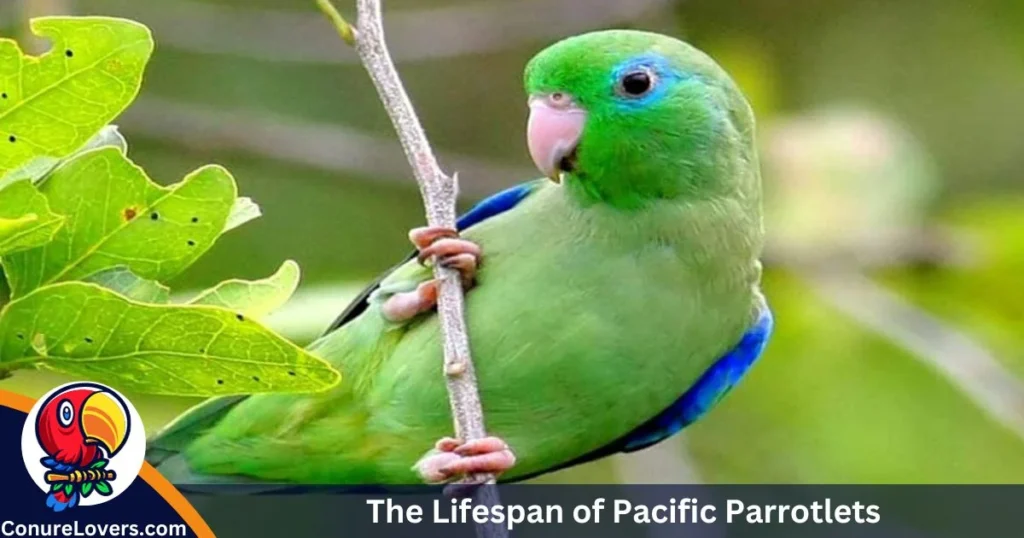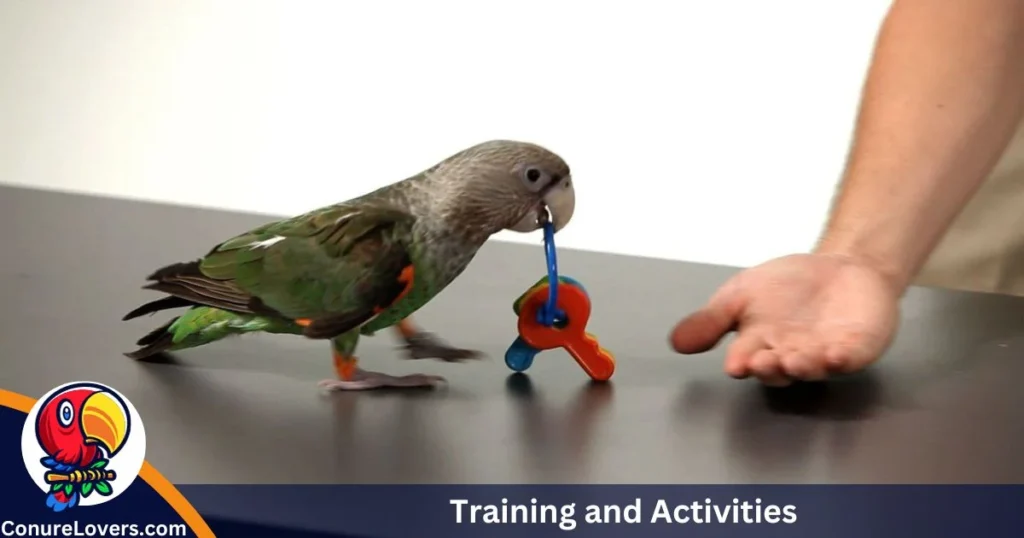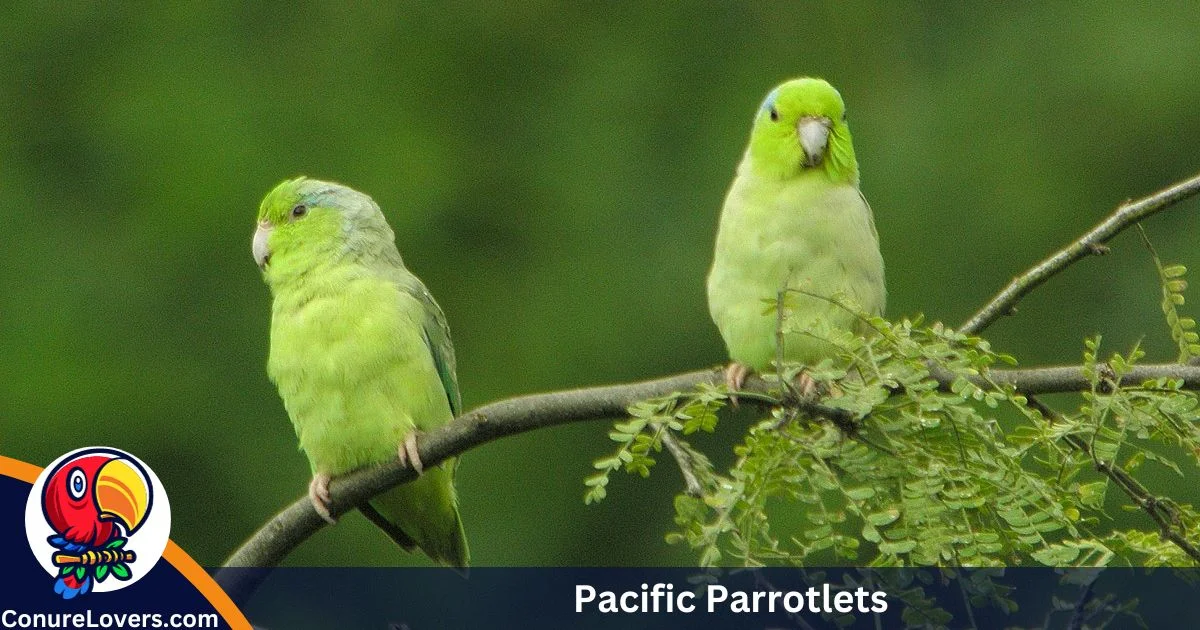“The Pacific parrotlet is a smart, brave, and inquisitive type of bird. Even though they are tiny, they act like big parrots and need a lot of attention. These parrotlets, especially the girls, really like having their own space. It’s best to keep them by themselves in their cage, or with just one other parrotlet.“
Don’t get fooled by their size! Pacific parrotlets, often confused with lovebirds or tiny Amazon parrots, are super charming, active, and curious. People love them because they’re pocket-sized and can even learn tricks.
These little birds, the world’s second smallest parrots, are like cousins to Amazon parrots. In the wild, you’ll find them in the Andes, western Ecuador, and northern Peru. Imagine this: they’re only about 5 inches small and weigh around 30 grams. Despite their tininess, they’ve got this cute wedge-shaped tail and relatively big beaks. It’s pretty fascinating, isn’t it?
So, next time you spot one, remember, there’s more to these little fellas than meets the eye!
Parrotlets’ Personality As Pets
Among all the parrotlet species, the Pacific parrotlet stands out as the most spirited and outgoing. But don’t let their feisty nature fool you! These little birds can form strong bonds with their owners and are surprisingly trainable and smart, despite their small size.
However, due to their spirited personalities, Pacific parrotlets might not be the best choice as family pets for children or young kids. Their feistiness and stubbornness can make them a bit nippy and territorial, especially if not handled regularly.
So, if you’re considering bringing a Pacific parrotlet into your home, it’s essential to be aware of their active and feisty tendencies. Regular training and handling are key to keeping them friendly and well-behaved. Establishing limits and boundaries during handling and training sessions can transform these birds into wonderful and loving companions for their owners.
The Lifespan of Pacific Parrotlets

Owning a pet is a big deal, especially when it comes to birds. Pacific parrotlets typically live for about 15-20 years, and some can even make it to a whopping 30 years.
So, before you jump into the decision of bringing a parrotlet into your life, take a moment to think about the long-term commitment involved.
Consider whether you’re ready to commit to caring for a bird that’ll need your attention for many years. This includes taking care of their home, covering vet fees and checkups, providing the right food, and keeping them mentally stimulated with enrichment.
It’s a big responsibility, but with the right commitment, it can be incredibly rewarding.
Read Also: Do Birds Fart or Burp? What’s That Stink?
Gender Sexing of Pacific Parrotlets
Parrotlets have a neat trick for telling boys from girls, and it’s all about the colors. You can easily figure out their gender just by looking at them! In the wild, male Pacific parrotlets flaunt cool cobalt blue streaks on their wings, behind their eyes, and on their rumps.
But here’s the catch: when it comes to the ones we keep as pets, they can come in all sorts of colors. Still, male parrotlets should always have those cobalt blue markings on their flight wings, unless they’re fancy with a lot of white spots or if they’re albino.
Now, let’s talk about the ladies. Female parrotlets won’t have that cobalt blue on the covert feathers of their flight wings, but they might show off a similar blue behind their eyes and on their rump.
To be absolutely sure about a parrotlet’s gender, you’ve got to spot that cobalt blue on the covert feathers of the flight wings – that’s the male signature! So, a little bit of color can reveal a whole lot about these charming birds.
Cage Requirements of Parrotlets

Even though parrotlets are small, their homes should be just right! They need a cage that lets them move around and spread their wings. The cage should be at least 18″x18″ (46cm x 46cm), but it’s even better if you can go bigger – the more space, the happier they are!
Now, here’s an important detail: check the bars. Make sure the gaps between them are no more than ½ inches (1.3cm). This stops the birds from getting their heads or bodies stuck in between. Think wide, not tall! Wider cages are a better pick because they let the birds move naturally. So, when it comes to their homes, it’s all about giving them the perfect space to live their best birdy lives!
Pacific Parrotlets’ Dietary Needs
Keeping your feathered friend healthy is all about the right grub! In the wild, Pacific parrotlets munch on grass seeds and fresh fruit, switching it up with the seasons. So, at home, it’s a good idea to give them a mix of goodies to keep them happy and thriving.
Here’s the menu rundown: start with high-grade pellets (cold-pressed ones are tops for these birds), toss in a quality seed mix, add some fresh chop (that’s a mix of fresh veggies), throw in fresh fruits, wholemeal pasta, sprouts, legumes, and whole grains. And don’t forget the basics – always have fresh, clean water within beak’s reach.
Now, about those proportions: while some owners like to measure out pellets, seeds, and fresh foods, remember this – parrotlets need seeds and nuts throughout the day. It’s like their fuel for those high metabolism rates, giving them the essential oils and fats they need for glossy feathers and an active lifestyle.
For the baby birds, start them young on a mix of fresh veggies, fruits, and pellets to avoid any picky eating habits later on. Early on, it’s all about setting them up for a lifetime of delicious and nutritious eats!
Cage Mates
Thinking about having your Pacific parrotlet share space with other birds? Here’s the lowdown:
With other bird species:
Keep it simple – parrotlets need their own space. Don’t mix them with different bird species because they might get aggressive and even harm larger birds. Safety first! If your parrotlet shows territorial or aggressive behavior, it’s best to keep it separate from other birds.
With other parrotlets:
In the wild, parrotlets hang out in flocks, but in captivity, it’s a different story. These little guys do best as solo acts. They can get territorial, especially during hormone-fueled seasons. If you’re set on having a pair, make sure the cage is roomy with plenty of space to fly around. This way, if a squabble breaks out, there’s room to escape. But to play it safe and avoid any birdie brawls, it’s still recommended to stick to one parrotlet per cage. Better safe than sorry!
Training and Activities

Parrotlets are super smart and curious little buddies, and they can even talk and mimic sounds. To keep them happy and thriving in your home, you’ve got to give them the mental workout they crave.
Here’s the plan: load up their cage with things to keep their minds buzzing. Think shreddable toys made of sola wood, mahogany wood pieces, or pine wood. Go for perches, but make sure they’re the natural wood kind, and secure them well to the cage. And don’t forget the swings – they love to play around and stay active!
Foraging baskets are a hit with many parrotlets. You can spice things up by hiding millet or their favorite treats inside, letting them do some natural foraging, just like they would in the wild. It’s all about keeping these little brains busy and their spirits high!
Conclusion
Even though they’re small, taking care of Pacific parrotlets is no small task. These little birds need a good amount of care, so don’t take having one as a pet lightly. But here’s the sweet part – they can become real buddies with their owners and make fantastic companions!
If you’re thinking of having a Pacific parrotlet as a pet, take some time to learn more about them. Understanding their quirks and needs will help you provide the top-notch care they truly deserve. It’s a bit of work, but the joy and friendship they bring make it all worthwhile!

It’s Ethan Richards, your Feathered Pal Expert from “Conure Lovers.” Let’s embark on a delightful adventure of conure companionship. I’ll share practical tips to ensure your feathered buddy lives a happy and healthy life.












